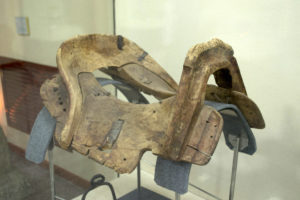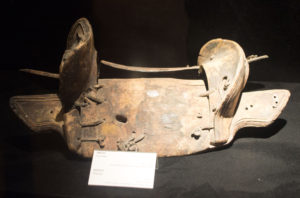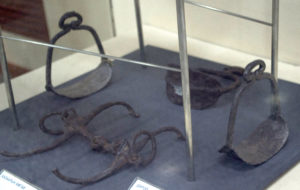Samuel Rumschlag
University of Wisconsin-Madison
In his landmark study of the rapid rise and decline of the Huns in the fifth century CE, E.A. Thompson observed that “history is no longer satisfied to ascribe so striking a movement as the rise of the Hun empire to the genius of a single man … it is only in terms of the development of their society that we can explain … how they came to build up so vast an empire of their own, and yet proved unable to hold it for more than a few years” (1996: 46). By making this claim, Thompson did not intend to diminish the role that gifted Hun leaders played in guiding their society to international prominence—only to point out that monocausal explanations cannot adequately capture historical reality in all its completeness. Leadership is obviously important, but even the most talented leader is limited by his or her circumstances.
Even so, much nomadic scholarship has tended to privilege charismatic leadership as one of the most important factors, if not the single most important factor, that contributed to successful nomadic military organization (see, for example, Di Cosmo 1999: 19-21; Drompp 2005: 108). This tendency comes to a head in studies of the Mongol expansion, where scholars note that Chinggis Khan successfully set up a ruling system based on loyalty to the “holy charisma” of the ruling house (Golden 2000: 36), redirecting old tribal loyalties from (real or fictive) kinship-based structures to a new and exclusive focus on duty to the Mongol royal house (Morgan 1986: 90). While these points and the scholarship that supports them are certainly valid, there is sometimes a tendency toward too great a focus on the importance of leadership at the expense of other important contributing factors to nomadic military successes.
Of course, leadership is not the only explanation offered for nomadic military prowess. The mobility of nomadic troops is also an oft-cited factor used to explain their military successes (Morgan 1986: 86; Thompson 1996: 55), as is the quality and number of mounts which made such mobility possible (Sinor 1972: 171). Other such factors often include nomadic battle tactics, such as the art of luring enemies into vulnerable positions before attacking them (May 2018: 1), along with specific political developments, in both nomadic polities and those of their adversaries, that altered the nomadic balance of power vis-à-vis their opponents. While worthy foci of scholarly attention, all these factors offer only a partial explanation of nomadic successes. Scholars should also look for additional factors that contributed to nomadic successes and can help explain historical realities that are only partially explained by appeals to leadership, mobility, politics, and tactics.
For example, it is significant that the Huns even at their peak under Attila never won a victory against a full-strength Roman field army, mostly chalking up victories against disorganized opponents when the Roman legions were engaged elsewhere. Every time the Huns did meet the Roman military for open battle proper, they either lost miserably or won Pyrrhic victories—Attila’s bloody victory over the Byzantine army in 447 CE is a good example (Thompson 1996: 227). The Mongols, on the other hand, routinely and ably trounced the best soldiers and armies the most powerful sedentary states could throw at them. I contend that gifted leadership or better use of mobile armies in the “exposed zones” where many nomadic victories were won and where nomadic political and cultural influence was most heavily felt (Lieberman 2008: 693) are not enough to explain these differential successes.
Likewise, overly simplistic explanations that attribute nomadic victories to superior numbers of combatants (Smith 1975: 272) or the incompetence of the nomad’s enemies (Smith 1984: 345) are the result of putting too much trust in flawed and fragmentary primary sources. Close analysis reveals that many of the innate advantages we assume nomadic societies to have enjoyed over their sedentary foes are in fact illusory. May (2006) has noted that although scholarship has tended to characterize nomadic armies as mainly achieving victory by “overwhelm[ing] their opponents through sheer ferocity or superior numbers” (517) or has simply brushed off their prowess by claiming that nomads were “natural warriors inured since birth to riding and archery in the harsh climate of the steppe” (517), nomadic armies were in fact often quite small when compared to those of their opponents (623) and required every bit as much training to become battle-ready as the professional soldiers they fought. Indeed, the martial lifestyle came no more “naturally” to them than to anyone else. Indeed, to many observers in the ancient world it must have seemed that the armies of stable sedentary states enjoyed innumerable advantages over their mobile counterparts: funding, equipment, supplies, professional leadership—the list goes on.
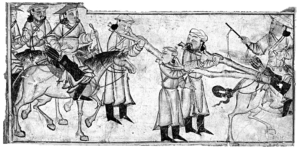
Fig. 1. Mongol riders escorting prisoners, from an early 14th-century illustration of Rashid ad-Din’s “Universal History” (Gami at-tawarih). The riders and mounts pictured on either side of the prisoners offer a glimpse of Mongol stirrups and quivers, while the mount on the left is also equipped with a saddle. Bibliothèque national de France, Département des Manuscrits, Division orientale, Supplement Persan 1113, folio 231v.
Why then do we see powerful armies in the service of sedentary states so often trounced by nomadic foes? Were nomadic victories really as “inevitable” as some incautious authors have claimed (Bartlett 2010), or is some other overlooked factor at play? To help explain nomadic successes, I will highlight one aspect of nomadic society that is not frequently discussed. I argue that superior military technology was as crucial to nomadic military victories as were other factors such as gifted leadership and extreme mobility. Improvements made to nomadic military technologies over time allowed successive nomadic groups to be increasingly successful vis-a-vis their sedentary enemies until the eventual invention of firearms leveled the playing field. Far from being a peripheral consideration, uniquely nomadic military technology operated simultaneously with good leadership and high mobility in successful nomadic armies, and each factor complemented the advantages conferred by the others. The loss of even one of these advantages would have seriously impoverished the ability of a nomadic society to mount successful campaigns against well-equipped sedentary foes.
An added benefit of incorporating technological improvements into our explanatory frameworks is the potential for such a perspective to explain not only nomadic victories over powerful sedentary foes, but also differential successes between different nomadic groups over time. Using two comparative case studies, I will argue that the mediocre successes of the Huns in the 5th century and the dazzling successes of the Mongols in the 13th century are due to differences in archery and saddle/stirrup technology in addition to other factors such as quality of military leadership. Despite the tendency of posterity to assume that one mounted archer is equal to another, from a technological perspective, this is simply not the case.
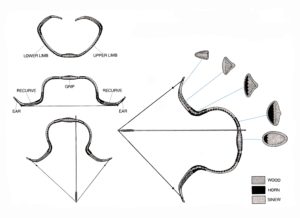
Fig. 2. Diagram of a composite bow. (After: Hank Iken, in Grayson et al. 2007, Traditional Archery from Six Continents)
Although the Huns and Mongols are hardly the only two nomadic groups to practice mounted archery successfully, several factors make them ideal for comparison. First, their origins trace to the same geographic area of the world (Kim 2016: 6; May 2006: 630). They were likewise both inheritors of similar nomadic military traditions derived from their common ancestral group, the Xiongnu (circa 300 BCE-200 CE) (Golden 2011: 33; Vaissere 2005). The Xiongnu were important technological innovators, introducing to mounted archery several important new developments, including paired stirrups in the fifth century CE and stiffening bone plates on the limb ends of their composite bows. The Huns of Europe had the stiffening bone plates that were first developed by the Xiongnu but lacked the technological innovations that the Xiongnu remaining in Inner Eurasia developed in the fifth century and subsequent periods, such as the paired stirrup. But by the time of the Mongols, these inventions had been widely adopted and mastered in Inner Eurasia. An understanding of Mongol technology, such as their use of paired stirrups and an improved composite bow design, is important in explaining the technological supremacy and, by extension, the enhanced military capabilities of the Mongols. Like leadership, tactics, and politics, however, any appeal to technology remains only one part of a larger composite picture.
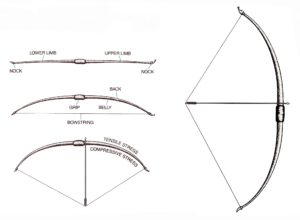
Fig. 3. Diagram of a self bow. (After: Hank Iken, in Grayson et al. 2007, Traditional Archery from Six Continents)
Not all aspects of Hun and Mongol military technology can be attributed to the Xiongnu. Both groups were inheritors of a long nomadic tradition of mounted archery, and the arsenal and practices of both groups reflect the contributions of many others. Still, though, at a foundational level Hun and Mongol military practices are marked more by similarity than by difference, and this makes the subtle differences that do exist between them especially illuminating. The Huns and Mongols are also comparatively well-studied archaeologically, with enough surviving examples of their bows and equestrian accoutrement to permit a thorough discussion that is well-grounded in empirical data.
The Technology of Mounted Archery
The primary weapon of every nomadic mounted archer was the composite bow, defined as a bow composed of at least three layers of varying materials (Reisinger 2010: 44). Sometimes, these bows are also termed “Scythian bows” after their supposed inventors (Mock 2013: 52). Composite bows are distinct from self bows, which are made from a single material such as a wooden stave, and laminated bows, which are made from several bonded layers of the same material, usually wood (Bergman, et al. 1988: 660). The earliest archaeological example of a nomadic composite bow dates to at least 1000 BCE., based on the 2010 discovery of a Scythian-style bow in the Yanghai cemetery of Xinjiang province in the People’s Republic of China (Beck, et al. 2014: 225; Karpowicz and Selby 2010: 94). All later nomadic bows were variants of this basic type. While far from common, these bows are not as archaeologically rare as one might think (Hall 2005: 28).1
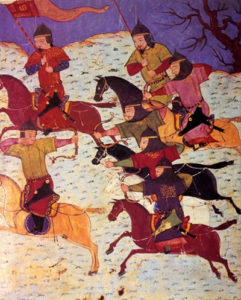
Fig. 4. Early 14th-century depiction of Mongol archers shooting with composite bows, from an illustration of Rashid ad-Din’s “Universal History” (Gami at-tawarih). Watercolor on paper. Bibliothèque national de France, Département des Manuscrits, Division orientale, Supplement Persan 1113, folio 231v.
For most nomads, the three dissimilar materials that comprised the composite bow were wood, horn, and sinew (Paterson 1984: 38). Wood forms the core and grip of the bow and is backed by sinew to add tensile strength. It is then fronted with horn, which has a high coefficient of restitution—that is, its springiness lets it return quickly to its original shape after being subjected to compression. The energy of the decompressing horn serves two purposes simultaneously: it lends power to the bow’s release and helps the front of the wooden core—the belly—resist compression amid repeated use (Bergman and McEwen 1997: 145; Reisinger 2010: 44). The sinew serves the same function: after being stretched, it returns quickly to its resting position, again protecting the wooden core of the bow and storing additional potential energy to be transferred to the arrow upon the release of the string. The impact on the capabilities of the finished bow are significant, as horn has 3.5 times the compression resistance of wood, while sinew can stretch five times as far as hardwood without breaking. The end result is a bow that both stores energy and transfers it to the arrow much more efficiently than a self bow, and is also much smaller (Bergman and McEwen 1997: 145). The application of these materials is not uniform and varies across space and time. Some bows, such as examples uncovered from Miran, China are backed with sinew nearly to the nocks (Hall and Farrell 2008: 90). Others, such as the Mongol-period Omnogov bow (discussed below) adopt a much more minimalist design that increases the recovery speed of the bow’s limbs and therefore its energy efficiency (Atex and Menes 1995: 75).
Composite bows are also often recurved, reflexed, or both. In a strung recurved bow, the limbs bend forward, away from the archer. In an unstrung reflexed bow, the entire limbs of the bow reverse themselves away from the direction of the draw. This innovation invests composite reflexed and recurved bows with greater efficiency than non-recurved or reflexed bows. By preloading tension on even the undrawn strung bow, the reflexing and recurving limbs allow more potential energy to be stored in the limbs at full draw with a lighter draw weight (due to the leverage conferred by the recurved limbs). This lends greater force and velocity to the arrow upon release and allows the bow unit to be physically much shorter without reducing the draw length, an important consideration for archers aspiring to shoot from horseback (Bergman, et al. 1988: 660; Reisinger 2010: 45). Self bows, on the other hand, cannot be shortened without significantly shortening the draw length, since wood unsupported by other materials can only bend so far before breaking. As an added benefit, the shortness of the composite recurve’s limbs make them lighter, so less potential energy is wasted moving the limbs back to their original position. This energy is instead transferred to the arrow, and ultimately, the target it impacts.2
When strung, many composite recurves are less than three feet from end to end. Most are in the vicinity of sixty centimeters (Drews 2004: 101). We might compare this figure to the English longbow, a self bow made from a single stave of yew or elm. These bows were usually six or more feet in length (~183 cm+) and required much more effort to draw than a similarly powerful recurve bow. Without the leverage of recurved limbs, and the additional potential energy stored in the sinew and horn of a composite bow, all the energy to be transferred to the arrow had to come from one source only: the muscle power of the archer, who bent the bow’s wood. Composite bows clearly were superior from this perspective, as they provided as much or more power with much less energy required for each draw (Emeneau 1953: 78). In addition to allowing more effective archery from horseback (longbows can be used from horseback with difficulty), short, efficient nomad bows allowed people who would never have been strong enough to draw an English-style longbow to be full participants in the nomadic mounted archer army. Composite recurve bows are also sometimes asymmetric, with the lower limb being shorter than the upper limb—an important design choice that allowed mounted archers to rotate easily to aim at targets on either side of their mount, provided they had the appropriate saddle technology to enable this. Despite the general features discussed above that were common in all composite bows, there were definite differences between Hunnic and Mongol bows that rendered Mongol bows superior in a variety of ways, differences that I propose were at least partially responsible for their differential successes on the battlefield.
Maintenance was a constant issue. Extreme temperature changes or exposure to dampness could warp the limbs, and twists in the limbs could render such bows inaccurate at best and useless at worst. Taybughā l-Ashrafī l-Baklamishī l-Yūnanī, a Mameluke author who penned an archer’s manual for beginners in the fourteenth century, advised archers in cold weather to “put the bow inside his clothes and warm it with his body. When going to bed at night, he should also keep the bow inside his clothes to protect it from the damp” (Latham and Paterson 1970: 94). Such discomfort was worthwhile given the difficulty of repairing warped limbs. In order do so, archers would have had to warm their bows over a fire and apply the appropriate corrective pressures. Even after careful and skilled repair, however, the bow would never be quite the same, especially if an overly zealous owner overcorrected for the original warping (Loades 2016: 27). Though the Huns used a bow that featured a design change that made it more durable in the long term, this came at the price of reduced energy transfer efficiency to the arrow.
Hun and Mongol Bows
In the seasonally variable and damp climate of eastern Europe, where most Hun sites are found, organic material such as horn, wood, and sinew do not preserve well. If these were the only components of Hunnic bows, archaeologists would be limited to the few fragmentary and questionable primary sources passed down to us by Roman historians with an interest in Hun culture. Fortunately, by the fourth century CE, a new technology had been applied to the traditional composite recurve design: stiffening bone plates attached to the grip and limb ends of bows, which minimized the warping effect that humidity and fluctuating temperatures could cause (Boie and Bader 1995: 29). Man (2005) compares the bone plates to fingernails on the end of a human digit (99). This is an apt analogy—the bone plates provide a rigidity to the limb ends that wood alone cannot, thus helping to prevent twist and warp. Although bows with this feature are frequently called “Hun bows,” the Xiongnu of Inner Asia from whom the Huns derived were actually the first to add such plates to the nomadic composite bow design, and such modifications appear across Eurasia after the initial Xiongnu heyday. Strictly speaking, it is therefore a pan-Eurasian design rather than a uniquely Hunnic design.3

Fig. 5. The Tsagaan Khad (White Rocks) bow. National Museum of Mongolia. All photos courtesy of author.
Hun tradition dictated that warriors be buried with their bows across their chest. A number of Hunnic graves across Europe and West Asia have yielded stiffening bone pieces that were recovered both intact and in situ (Loades 2016: 17). Careful measurements have allowed for the reconstruction of the size and shape of the original bows, though unfortunately without the other original materials of construction. For archaeologists, the inclusion of these stiffening plates is fortunate, for the bone they are made from preserves quite well in poor conditions. They therefore allow us to study the construction of Hun bows that have otherwise long since decomposed.
The durability these plates added to Hun bows came at the price of efficiency. Bone is heavier than the other materials that make up composite bows, and therefore, it takes more of the drawn bow’s potential energy to accelerate these heavy bone additions and move them back to the strung, undrawn position. While this is also true of horn and sinew, the crucial difference is that both horn and sinew store additional potential energy in a drawn composite bow, more than compensating for their use of some additional potential energy during release. The stiffening bone plates, on the other hand, consumed energy without contributing any. The energy used to move them, which would otherwise have been transferred to the arrow, was instead lost, with a result of decreased arrow velocity and penetration at the point of impact. It is not currently possible to determine the exact amount of lost energy per shot, since without the specifications of the other materials in the bow it is impossible to do so accurately. Given the weight of the bone, however, the amount of lost energy entailed by such an addition must have been significant (Atex and Menes 1995: 75).
As far as the limited archaeological evidence can demonstrate, conquest-period Mongol bows were virtually identical to Hunnic bows, minus the stiffening bone plates. Modern Mongolian bows are of no comparative use here; by the 17th century, the Mongols had abandoned the use of the bow in war and it was only in the mid-eighteenth century that they re-adopted a variation of the Chinese Manchu/Qing bow into their arsenal. Qing bows, designed to compete with European muskets by delivering extremely heavy arrows at high velocities, are much larger and heavier than the Mongol conquest-period bows. Michael Loades describes them aptly as “the longest and most massive of all composite bow types … it was a bow for the power shot, rather than the rapid shot” (2016: 20-21). As such, they were very different from the light but still powerful bows of the Chingissid Age.
Only two complete conquest-period Mongol bows have ever been found, the most recent one in 2010 in a cave at Tsagaan Khad (White Mountain) in modern Mongolia’s Ovorkhangaj Aimag. The dry cave environment in which it was deposited allowed for an extraordinary level of preservation: even traces of the original red, black, and yellow pigments survive, along with inlaid gold leaf. Dating to the 14th or 15th century CE, even the red silk string survived intact—upon recovery, the bow was still strung (Loades 2016: 19). The stress on the limbs resulting from being constantly tensed by the string over many centuries resulted in significant warping, but not so much that the original shape, specifications, and composition of the bow could not be analyzed (details in Ahrens, et al. 2015: 685; Biro 2013: 17).
The other conquest period bow is even better preserved, and similarly designed. The Omnogov Bow, as it is known, was discovered in 1984, also in a cave burial, at Ikh Bayany Agui in Mongolia’s Omnogov Aimag. Though some scholars have suggested that the bow dates to as late as 1720 CE, most analysts agree that the bow is in fact much earlier, dating to the 12th or 13th century CE (Ahrens, et al. 2015: 686). The virtually identical design of the convincingly dated Tsagaan Khad bow lends support to the earlier date. The Omnogov Bow, like all known Mongol-period bows, lacked the stiffening bone plates of the older Hunnic bows. The elimination of the performance-reducing bone stiffeners to the limb ends of the bow is the primary design difference between Hunnic and Mongol bows, one which rendered Mongol bows superior. According to Atex and Menes, “doing away with the mass and weight of the bone tips would have added a considerable amount of speed to the bow.” Bone, and the adhesives needed to bond it to the wooden core, they note, is roughly twice the weight of an equivalent amount of hardwood. Thus its elimination “would allow a much higher recovery speed of the tips, greatly increasing arrow speed.” The Mongol bow, then, “was a little shorter than that of the Hun and with the light tips would have been far superior” in terms of arrow speed (1995: 75).
While the stiffening bone plates of the Hunnic bows made them more durable, they would have added weight to the bow that resulted in wasted energy from every shot, which translates into lower arrow velocities, penetrating power, and shorter ranges. The significance of even a slight edge in terms of arrow velocity, range, and penetrating power should not be underestimated. Although such an observation alone is clearly not enough to explain Hunnic successes versus Mongol successes, we should bear in mind that different weapon capabilities doubtlessly played at least some role in the differential military successes of the two groups. In the future, perhaps detailed reconstructions of the Tsagaan Khad and Omnogov bows will permit more detailed assessments of their capability. If a complete Hunnic bow is ever found and reconstructed, a much more rigorous comparison of their differential capabilities could be undertaken.
But the recurved composite bow was not the only crucial piece of military technology deployed by the nomads. Saddles, and especially the later addition of stirrups, provided the platforms from which mounted archers traveled and fought. Therefore, in order to fully understand the battlefield dynamics of nomadic armies, an examination of saddle and stirrup technological innovations is essential. Again, the Mongols enjoyed a subtle but significant technological advantage over the Huns, one that made them much more deadly as mounted archers. The Huns of the fourth and fifth centuries CE used wooden saddles without paired stirrups. This is confirmed not only by archaeological finds but also by primary source texts. The textual basis for this claim comes from a reference in Jordanes’ Getica. Jordanes, a Gothic historian, wrote from Constantinople in 551 CE, a century after the Huns and Romans clashed at the Battle of the Catalaunian Plains. Jordanes records that Atilla, sensing defeat, ordered a great funeral pyre of saddles to be erected, on which he would throw himself into the flames so as to deprive the Romans the satisfaction of killing or capturing him (Jordanes 2014: 43). The fact that saddles were suitable for a pyre is ample evidence that they were wooden. Archaeological evidence lends further support to this. In fact, during this period, wooden saddles among nomadic groups were the norm rather than the exception; in fact, they are well-attested pieces of nomadic equestrian accoutrement in many places and times (Tkačenko 2010). But in the case of the Huns, there is no evidence of stirrups, either in textual or archaeological sources. (There is disagreement among scholars whether the Huns used cloth or leather toe loops strictly as mounting aids, along with how widespread the toe loops may have been if they existed at all.)
The Roman cavalry, which was contemporaneous to the Huns, used wooden saddle technology without stirrups that was borrowed from the Parthians. Presumably, then, the presence and utilization of stirrups would have been worth observing, recording, and discussing for Roman authors. Though excavations at Hunnic sites have turned up bits, fragments of wooden saddles, and bridle ornaments, not a single stirrup or anything that could be interpreted as one has been found (Istvanovits and Kulcsar 2014: 269; Maenchen-Helfen 1979: 209; Man 2005: 56); it is generally agreed that stirrups did not reach Europe until the arrival of the Avars in the late 6th or early 7th century CE (May 2018: 5).
Although the lack of stirrups was a challenge to the practice of horse archery for groups like the Huns, it was not an insurmountable one. Loades, based on experiments conducted using a Parthian wooden four-horn saddle without stirrups (a nomadic design temporally close to the time of the Huns), has noted that leaning into the front horns lifted the rider’s seat almost as effectively as standing in paired stirrups, and enabled their hips to absorb shocks and minimize the jostling that can disrupt aim at the moment of shooting. Stirrups, he concludes, were not an essential prerequisite for horse archery. Archaeological evidence of Loades’ technique for practicing mounted archery with Parthian four-horn wooden saddles can be found in a stone carving of a Parthian mounted archer held in Berlin’s Museum für Islamisches Kunst (Driel-Murray, et al. 2002: 17; Loades 2016: 55).
The lack of stirrups constituted a significant handicap for mounted archers, even if it was not insurmountable. Stirrups enable a more stable platform for shooting by allowing archers to rise partially in the saddle and use their knees as shock absorbers, and this in turn allowed the archer to recruit their leg and core muscles in order to draw heavier bows while riding. From a seated position, only the muscles of the arm and chest can be recruited into the draw. Without the muscles of the leg and core to aid in drawing, the Hunnic bows would most likely have been lighter in draw weight than later Mongol bows. The lack of preserved organic material from a Hunnic bow precludes the calculation of draw weights, but we can combine this observation with evidence noted above: namely, that the stiffening bone plates of Hunnic bows would have reduced their efficiency. Therefore, even at the peak of Hunnic prowess, Hunnic bows would have been inferior to the Mongol bow in three ways: draw weight, energy transfer efficiency, and in the absence of sturdy paired stirrups, ease of handling from horseback.
A skilled rider equipped with stirrups can control a horse with his or her knees even without placing his hands on the reigns. For a Hunnic rider, the only solid point of contact with the horse while shooting would have been the hips/pelvis. Without stirrups, hands-free control of the horse would have been impossible. In order to control their horses, Hunnic soldiers would have had to cease firing and grasp the reigns. Though Loades’ experiments demonstrate that mounted archery can be practiced with only a good wooden saddle, it also provides evidence that mounted archery is much more effective if the rider can control the horse and fire their bow at the same time.
Another decisive liability that came with the Hunnic lack of stirrups was the inability of riders to inflict or sustain a shock while on horseback without being dismounted (Christian 1998: 281; Dien 1986: 36; Goodrich 1984: 285; White 1964: 1-2). The inability to maneuver one’s position in the saddle while riding at high speeds—let alone while shooting—without stirrups was also disadvantageous. The Xiongnu who threatened the northern frontier of Han China provide compelling evidence that pre-stirrup strategies were largely limited to hit-and-run style raids rather than prolonged conflict with enemy armies (Christian 1998: 191; Drews 2004: 116). The Huns, who never won a battle against a full-strength Roman field army and inflicted most of their damage in the absence of serious organized resistance, exemplified this strategic approach. While effective in certain settings, such limited capabilities were best paired with strategies that aimed to keep an enemy off balance rather than engage them in a prolonged war of conquest. Not surprisingly, this is precisely the sort of behavior ancient authors record the Huns as excelling at.
Of course, hit and run strategies remained important to pastoralists even after the acquisition of the stirrup, but its acquisition allowed pastoralist tactics to evolve in several significant ways that made them devastating to opponents, especially foot armies. The horned wooden saddles of the Hunnic period were a tremendous improvement over earlier Scythian period “soft saddles,” which consisted of two leather pads, sewn together, filled with hair or plant material, and crudely attached to the horse with a simple girth strap (Olsen 1988: 186; Tkačenko 2010: 1). Such simple saddles are known archaeologically from the 5th to 3rd century BCE Pazyryk burials. But still, the lack of stirrups was a serious military handicap for the Huns, one that limited the effectiveness of their engagements with Roman military forces. Nearly a millennium later, however, exploiting the advantages of better bow and saddle/stirrup technology would have been second nature to the Mongols—and enabled them to engage even the best-trained infantry or heavy cavalry army much more effectively than the Huns had ever done.
It should be noted that Mongol saddles were also wooden. Not only that, but Mongol bows were morphologically similar to those of the Huns. However, Mongols saddles and bows were combined with sturdy paired stirrups. Again, this is attested both archaeologically and textually. Generally speaking, usually only women made leather and cloth goods among the Mongols, as recorded by William of Rubruck in the thirteenth century (Dawson 1966: 97). Men are very clearly listed as the makers of wooden and metal goods: “the men make bows and arrows, manufacture stirrups and bits and make saddles …” (Dawson 1966: 103). The Mongols retained the nomadic tradition of crafting saddles from wood and paired them with metal (probably iron) stirrups.
It is, however, not likely that stirrups were a recent invention at the time of the Mongols. Tkačenko (2010: 2) claims that saddles and stirrups were first paired sometime in the early first millennium CE in the region of the Xiongnu confederation, from whom the Huns split off and the Mongols descended. Littauer (2002: 439) argues for an even more precise origin point in the 5th century CE, and May (2018: 5) supports the view that they were present among the Xianbei (a nomadic group who lived in what is today eastern Mongolia, Inner Mongolia, and Northeast China) by the early 4th century CE, from whence they made their way into China proper. Given the Hunnic lack of stirrups, it seems clear that the technology developed too late for the migrating Huns to carry with them on their way west to Europe, but probably developed shortly thereafter. So though the Huns lacked stirrups, by the time of the Mongols, Inner Eurasian nomads had possessed them and been mastering their use in combat for nearly a millennium.
Ultimately, technology, like leadership or mobility, is only one piece of a tangled web of intertwined causes and effects that tell the tale of nomadic warfare. It would be misguided to attribute the rise of a stunningly successful nomadic group like the Mongols to superior technology alone. There were many nomadic groups who were chronologically much closer in time to the Mongols than were the Huns that possessed similar riding technology but did not come even close to achieving the same military successes. This alone should be taken as sufficient evidence that leadership, politics, and so forth retain a considerable degree of explanatory utility. To appeal to technology alone would be to vastly overstate the case the evidence supports. At the same time, however, it would be equally foolish to ignore the role that technology played in enabling some nomads to best their sedentary peers where their predecessors had been only annoyances. In the future, perhaps detailed reconstructions of nomadic bows will permit detailed calculations of draw weights and, in turn, arrow speed and penetrating power. If a complete Hunnic bow is ever discovered, similar reconstructions would allow the precise effect of the performance-limiting bone plates to be assessed. But even if such discoveries never come to light, the evidence that does exist more than supports the thesis that considerations of technology deserve to be integrated into analyses of nomadic societies much more thoroughly than they previously have been.
About the Author
Samuel Rumschlag is a Ph.D. student in the Department of Anthropology at the University of Wisconsin-Madison. His research focuses on conflict between nomadic steppe peoples and early Chinese dynasties in the frontier region of what is now southern Mongolia and northern China. E-mail: <rumschlag@wisc.edu>.
Acknowledgments
The author would like to thank the Center for Russia, Eastern Europe, and Central Asia at the University of Wisconsin-Madison, who provided research funding for travel to Mongolia where much of this research was conducted. Thanks are also due to the Department of Anthropology at the University of Wisconsin-Madison for their generous support over the past two academic years, and to Dr. Nam C. Kim and Dr. J. M. Kenoyer, my academic advisers for their generous gifts of guidance, insight, and time during my graduate career so far.
References
Ahrens et al 2015
Birte Ahrens, H. Piezonka, and G. Nomguunsuren. “Buried with His Bow and Arrows: The Exceptional Cave Burial of a 14th Century Warrior at Tsagaan Khad Mountain, Mongolia.” In: T. La, ed., Ancient Cultures of the Northern Area of China, Mongolia and Baikalian Siberia, Beijing: Huhhot, 2015: 683-91.
Atex and Menes 1995
Wayne Atex and G. Menes. “The Omnogov Bow: The Results of a Search for the Bow of Genghis Khan.” Journal of the Society of Archer Antiquaries 38 (1995): 71-75.
Baker 1992
T. Baker. “Bow Design and Performance.” In: J. Hamm, ed., The Traditional Bowyer’s Bible, Azle: Bois d’Arc Pr., 1992: 43-116.
Balfour 1890
Henry Balfour. “On the Structure and Affinities of the Composite Bow.” Journal of the Anthropological Institute of Great Britain 19 (1890): 220-50.
Beck et al. 2014
Ulrike Beck, Mayke Wagner, Xiao Li, Desmond Durkin-Meisterernst, and Pavel E. Tarasov. “The Invention of Trousers and Its Likely Affiliation with Horseback Riding and Mobility: A Case Study of Late 2nd millennium BC Finds from Turfan in Eastern Central Asia.” Quaternary International 348 (2014): 224-35.
Bergman and McEwen 1997
Christopher Bergman and Edward McEwen. “Sinew-Reinforced and Composite Bows: Technology, Function and Social Implications.” In: H. Knecht, ed., Projectile Technology, New York, Plenum Press, 1997: 143-60.
Bergman et al. 1988
Christopher A. Bergman, Edward McEwen, and R. Miller. “Experimental Archery: Projectile Velocities and Comparison of Bow Performances.” Antiquity 62 (1988): 658-70.
Biro 2013
Adam Biro. “Methodological Considerations on the Archaeology of Rigid, Reflex, Composite Bows of Eurasia in the Pre-Mongol Period.” Acta Militaria Mediaevalia 9 (2013): 7-38.
Boie and Bader 1995
A. Boie and H. D. Bader. “Bows Used by the Huns.” Journal of the Society of Archer Antiquaries (1995): 28-32.
Christian 1998
David Christian. A History of Russia, Central Asia and Mongolia. Malden: Blackwell, 1998.
Dawson 1996
Christopher Dawson, ed. Mission to Asia: Narratives and Letters of the Franciscan Misisonaries in Mongolia and China in the Thirteenth and Fourteenth Centuries. New York: Harper, 1996.
Di Cosmo 1999
Nicola Di Cosmo. “State Formation and Periodization in Inner Asian History.” Journal of World History 10, no. 1 (1999): 1-40.
Dien 1986
Albert E. Dien. “The Stirrup and Its Effect on Chinese Military History.” Ars Orientalis 16 (1986): 33-56.
Drews 2004
Robert Drews. Early Riders: The Beginnings of Mounted Warfare in Asia and Europe. New York: Routledge, 2004.
Driel-Murray et al. 2002
Carol van Driel-Murray, Peter Connolly, and John Duckham. “Roman Saddles: Archaeology and Experiment 20 Years On.” In: L. Gilmour, ed., In the Saddle: An Exploration of the Saddle Through History. London: Archetype, 2002: 1-19.
Drompp 2005
Michael R. Drompp. “Imperial State Formation in Inner Asia: The Early Turkic Empires (6th to 9th Centuries).” Acta Orientalia Academiae Scientiarum Hungaricae 58, no. 1 (2005): 101-11.
Emeneau 1953
Murray B. Emeneau. “The Composite Bow in India.” Proceedings of the American Philosophical Society 97, no. 1 (1953): 77-87.
Golden 2000
Peter B. Golden. “‘I Will Give the People unto Thee’: The Činggisid Conquests and Their Aftermath in the Turkic World.” Journal Of the Royal Asiatic Society 10, no. 1 (2000): 21-41.
Golden 2011
Peter B. Golden. Central Asia in World History. New York: Oxford University Press, 2011.
Goodrich 1984
Chauncey S. Goodrich. “Riding Astride and The Saddle in Ancient China.” Harvard Journal of Asiatic Studies 44, no. 2 (1984): 279-306.
Hall 2005
Andrew Hall. “Some Well-Preserved Composite Bows.”Journal of the Society of Archer Antiquaries 48 (2005): 28-36.
Hall and Farrell 2008
Andrew Hall and Jack Farrell. “Bows and Arrows from Miran, China.” Journal of the Society of Archer Antiquaries 51 (2008): 89-98.
Istvanovits and Kulcsar 2014
Eszter Istvanovits and Valeria Kulcsar. “New Find of Hun Age Saddle Plates From North-East Hungary.” In: S. Cocis, ed., Archäologische Beiträge: Gedenkschrift zum hundertsten Geburtstag von Kurt Horedt, Cluj-Napoca: Patrimonium Archaeologicum Transylvanicum, 2014, 269-78.
Jordanes 2014
Jordanes. The Origin and Deeds of the Goths. Translated by C. C. Mierow. San Bernardino: Hard Press, 2014.
Karpowicz and Selby 2010
Adam Karpowicz and Stephen Selby. “Scythian Bow from Xinjang.” Journal of the Society of Archer Antiquaries 53 (2010): 94-102.
Kim 2016
Hyun Jin Kim. The Huns. New York: Routledge, 2016.
Kooi 1996
B.W. Kooi. “Functioning of Ears and Set-back at Grip of Asiatic Bows.” Journal of the Society of Archer Antiquaries 39 (1996): 73-77.
Latham and Paterson 1970
J.D. Latham and W.F. Paterson. Saracen Archery. London: Holland Press, 1970.
Lieberman 2008
Victor Lieberman. “Protected Rimlands and Exposed Zones: Reconfiguring Premodern Eurasia.” Comparative Studies in Society and History 50, no. 3 (2008): 692-723.
Littauer 2002
Mary Aiken Littauer. “Early Stirrups.” In: P. Raulwing, ed., Selected Writings on Chariots and Other Early Vehicles, Riding and Harness, Leiden: Brill, 2002, 439-51.
Loades 2016
Michael Loades. The Compound Bow. Oxford: Osprey, 2016.
Maenchen-Helfen 1979
Otto Maenchen-Helfen. The World of the Huns: Studies in Their History and Culture. Los Angeles: University of California Press, 1979.
Man 2005
John Man. Attila: The Barbarian King who Challenged Rome. New York: Thomas Dunne, 2005.
May 2006
Timothy May. “The Training of an Inner Asian Nomad Army in the Pre-Modern Period.” Journal of Military History 70, no. 3 (2006): 617-35.
May 2018
Timothy May. “Nomadic Warfare Before Firearms.” In: Oxford Research Encyclopedia of Asian History. Available online: http://oxfordre.com/asianhistory/view/10.1093/acrefore/9780190277727.001.0001/acrefore-9780190277727-e-4
Mock 2013
John Mock. “New Discoveries of Rock Art in Afghanistan’s Wakhan Corridor and Pamir: A Preliminary Study.” TheSilk Road 11 (2013): 36-53.
Morgan 1986
David Morgan. The Mongols. Oxford: Blackwell, 1986.
Olsen 1988
Stanley J. Olsen. “The Horse in Ancient China and Its Cultural Influence in Some Other Areas.” Proceedings of the Academy of Natural Sciences of Philadelphia 140, no. 2 (1988): 151-89.
Paterson 1984
W.F. Paterson. Encyclopaedia of Archery. London: Robert Hale, 1984.
Reisinger 2010
Michaela Reisinger. “New Evidence about Composite Bows and Their Arrows in Inner Asia.” The Silk Road 8 (2010): 42-62.
Sinor 1972
Denis Sinor. “Horse and Pasture in Inner Asian history.” Oriens extremus 19, no. 1 (1972): 171-83.
Paterson 1984
W.F. Paterson. Encyclopaedia of Archery. London: Robert Hale, 1984.
Smith 1975
John Masson Smith Jr. “Mongol Manpower and Persian Population.” Journal of the Economic and Social History of the Orient 18, no. 3 (1975): 271-99.
Smith 1984
John Masson Smith Jr. “Ayn Jālūt: Mamlūk Sucess or Mongol Failure?” Harvard Journal of Asiatic Studies44, no. 2 (1984): 307-45.
Paterson 1984
W.F. Paterson. Encyclopaedia of Archery. London: Robert Hale, 1984.
Thompson 1996
E.A. Thompson. The Huns. Cambridge: Blackwell, 1996.
Tkačenko 2010
Irina Dmitrievna Tkačenko. “Riding Horse Tack among the Cattle-breeders of Central Asia and Southern Siberia in the First and Second Millennia CE.” Études mongoles et sibériennes, centrasiatiques et tibétaines 41 (2010). Available online: https://journals.openedition.org/emscat/1552
De la Vaissere 2005
Etienne de la Vaissere. “Huns et Xiongnu.” Central Asiatic Journal 49, no. 1 (2005): 3-26.
White 1964
Lynne White. Medieval Technology and Social Change. Oxford: Clarendon, 1962.
Endnotes
1 Biro (2013) has provided a thorough discussion of the terminology surrounding the academic study of archaeological finds relating to archery.
2 For a more detailed discussion of bow mechanics, see Baker 1992, Balfour 1890, Kooi 1996, Loades 2016, and McEwen et al. 1991.
3 Though I have retained the designation “Hun bow” to describe the technology employed by the Huns of Europe, readers should remain aware that the application of the bone plate technology was unique neither to the Huns or to Europe.


